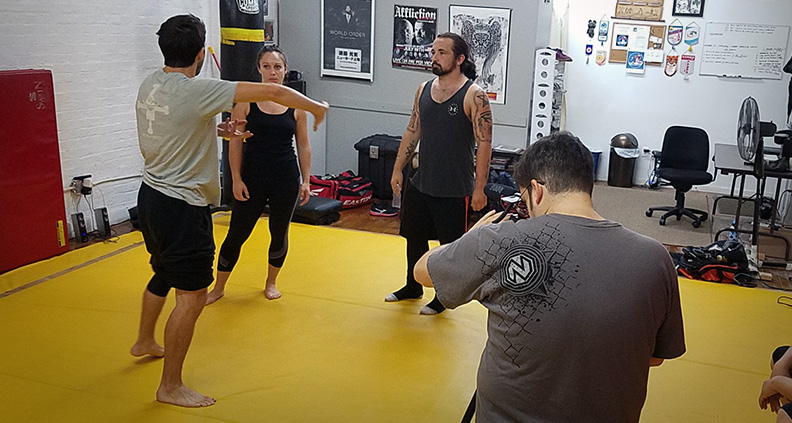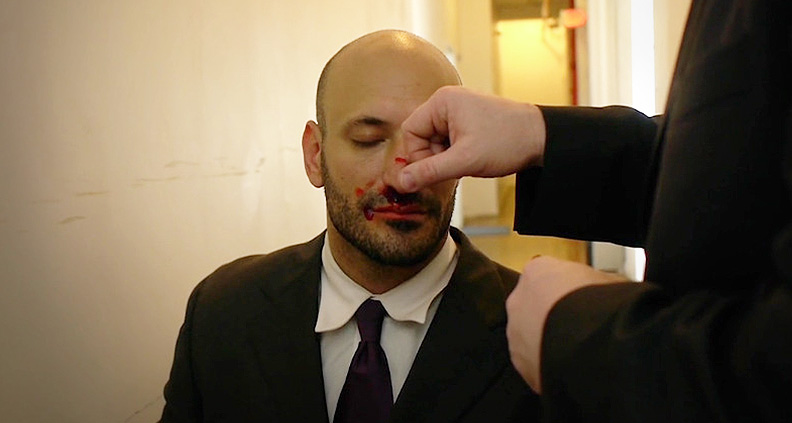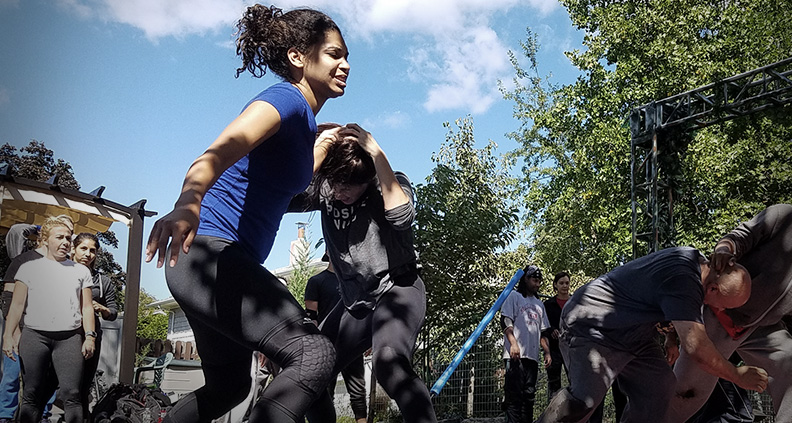Concrete and Crashpads: Behind-the-Scenes Insight from Top Stunt Performers
Think of the last movie you saw. Don’t worry about the genre. In this movie, were there people getting punched? Car chases? Gunplay? Explosions? Characters jumping absurdly long distances? Physical comedy and/or contact sports? Chances are there were at least a few of these—or, if you were watching Lethal Weapon 3 or The Longest Yard, all of ‘em. And for that, you can thank your friendly neighborhood stunt coordinators and performers.
Unfortunately, it can be too easy to take stunt performers for granted. They’re invisible by design. They’re supposed to be mistaken for the project’s above-the-line talent, their physical dexterity and exacting craft disguised as violence and random chaos. And as recent fatal tragedies on the sets of The Walking Dead and Deadpool 2 grimly attest, it’s a job that’s not just difficult, but dangerous.

Such is the subject of Matthew Kaplowitz and Stephen Koepfer’s new documentary short, Concrete and Crashpads, profiling several hardworking members of the New York stunt community. Kapowitz and Koepfer co-directed the film, with Kaplowitz also serving as the film’s DP and editor, and Koepfer as executive producer. The film has screened at numerous festivals, and has played as part of SAG-AFTRA’s “The Business” screening series.
We recently spoke to Kapowitz and Koepfer, as well as to several of the subjects of the film—all members of the New York City stunt community—about the film, the best ways to avoid getting hurt and their all-time favorite stunts. Here’s the conversation:
CONCRETE AND CRASH PADS

What attracted you to the world of stunt performers as a documentary subject?
Koepfer: As a rookie stunt performer, this film allowed me to shed some light on a community I have grown to admire and respect. It was an opportunity for a creative cross-pollination of my passion for martial arts, films and stunts.
Kaplowitz: Steve reached out with his idea and asked me to help. I helped refine the idea and turn it into a compelling narrative; instead of a straight-up educational doc. I wanted to make [the film] into something as exciting to watch as what these performers do when they’re on set. The business of stunts can be life and death, so we wanted to give viewers some context by really showing, from a firsthand perspective, what goes on.
What did you learn about stunts while making this film that you didn’t expect?
Koepfer: This film taught me so much about the stunt profession. Something that was surprising to learn was how so many people who make a living in front of the camera as someone else will actually hesitate to be on camera as themselves.
Kaplowitz: I learned about the stunt actor community and how supportive they are of each other. Many other aspects of TV and film are highly competitive and cutthroat, and while there is a fight to get work, there seems to be a sense of helping each other out. If a job isn’t suited for one person, they’ll say, “Hey, I know someone who can do this!” Hearing about some of the harsher and more painful stunts was a little shocking. It’s one of those things a viewer takes for granted, because they tend to happen so fast on screen. But if you remind yourself an actual human being is getting hit by a car, falling through glass or being set on fire, it puts a new light on things.
What’s the biggest difference between actual fighting and what we see on TV and in movies?
Kaplowitz: You can’t fake authentic skills, so you have to be an authentic fighter to make the scene feel real. The biggest difference is that when you are fighting for film or TV you don’t want to hit the person. So you have to create the illusion of hitting a person, or—more often—being hit by a person. Selling a punch is not as easy as it looks, and the best way to learn is to do it in training.
How has stunt performing been impacted by visual effects and CGI?
Koepfer: I think technology has transformed stunts in ways that make the profession safer. With green screen, for example, extreme high falls, fire burns, etc. are much less frequent. Technology has also added new tools to a stunt coordinator’s palette. In the end though, I think the vast majority of stunts remain the same: fighting, falling, driving, getting shot, getting punched.
What’s your favorite stunt from a movie, and why?
Koepfer: I have several. Recently, I really enjoyed and appreciated a fight scene in HBO’s The Leftovers. It was Season Two, in the “International Assassin” episode. I love when fights are gritty, realistic and credible with regard to fighting technique. The fight in this episode was fast, brutal and very believable. It was beautifully choreographed and shot. I always use it as an example of how a quick fight of just 10 or 12 beats can leave the viewer wide-eyed and breathless.
Kaplowitz: There are so many good ones, but I think the one I talk about the most often is Jackie Chan in Police Story from 1985. That movie has a lot of great stunts, but the one it’s probably best known for is from the end of the movie. The giant stunt that Jackie does is still incredible to watch. He has to get from one floor of a mall to the bottom floor in order to retrieve the MacGuffin after fighting off a ton of thugs and the fastest way down is leaping onto a single strand of wire from a light fixture in the ceiling and sliding down it to the ground floor. No safety net, one jump—and he does it! Not only was it a tremendously impressive stunt, but it also fit perfectly into the story. The insane leap was 100% necessary and made sense for this character to take that risk.
https://www.youtube.com/watch?v=IMlG-EVoqFw
STUNT PERFORMERS

We also caught up three of the film’s subjects: stunt performer and actress Hannah D. Scott and stunt performers/actors/producers Jeremy Sample and Federice Berte. Here’s what they had to say:
When did you first realize there was such a thing as a stunt performer?
Scott: I think I’ve always been aware. Perhaps as a kid I thought more things were special effects than they were real people.
Sample: I was in high school. I often saw references to stunt performers while watching various segments showcasing the behind-the-scenes action for movies.
Berte: While studying and training in martial arts in China, I discovered what stunt performers do and decided to become one!
What made you want to be a stunt performer?
Scott: I actually remember the day I called my mentor and said, “I want in.” I couldn’t think of or find a better way to combine being an athlete with my love of film and creativity. It’s amazing.
Sample: I saw performing stunts as a new and exciting career path that had excellent work-life balance.
Berte: As I mentioned, I started in martial arts while training in China, which led me into becoming a stunt performer. Now, I’m getting into fight choreography and directing.
What’s your area of expertise and why/how?
Scott: I don’t think I have one yet, to be honest. I’m still new to this, my martial arts skills, maybe a different style—for example, Panantukan [a Filipino martial art.] But it’s not a stunt expertise.
Sample: I was a collegiate athlete, a football player, who learned a large number of skills after I became a stuntman: delivering dialogue, “ground and pound” (going aggressively to the ground), fighting, ride wires (e.g., simulated air travel using a jerk vest and Tech-12 rope), working on stunt rigging teams and performing various driving maneuvers.
Berte: Any kind and style of fight scene—I’ve been training in martial arts for more than 25 years.
How’d you get into the stunt industry?
Scott: That’s one of the most difficult things to answer. There are no schools or “Do A and you’ll achieve B” results. Everyone has a vastly different path into this.
Sample: At the time there was a shortage of African-American stuntmen needed for a riot scene and I was available. Fast-forward 12.5 years and I’m coordinating stunts for movies and television shows.
Berte: I got into the stunt industry by training with other stunt people, creating a stunt reel and networking. Also, meeting with stunt coordinators.
What are three things budding stunt performers should know about avoiding injury?
Scott: Listen to your stunt coordinator. Don’t be afraid to ask questions. Don’t say you can do something you can’t just for the job.
Sample: My three tips are to have adequate time to prepare and rehearse a stunt, to be aware of your surroundings at all times and to ensure you have proper safety gear on your body.
Berte: Awareness. Know how to fall. Be humble and say “no” if you’re not 100% percent sure you can do the stunt.
What’s your favorite stunt from a movie and why?
Scott: This is so hard to answer but I recently saw Mad Max Fury Road. Some of those chase sequences are incredible.
Sample: My favorite stunt sequence is a scene I coordinated on Selma. It was the death of Jimmie Lee Jackson in the diner during the night march. The action truly resonated with people and caused them to feel something. Hearing and seeing people crying in a movie theater meant I did my job.
Berte: All of Jackie Chan’s movies, because he’s crazy! Nobody sane would even try to do what he does, especially in the early days—impressive to just watch.
To learn more about Concrete and Crash Pads, please visit the film’s Facebook page. Learn how to become a Member of Film Independent by visiting our website, and click here to subscribe to our YouTube channel.